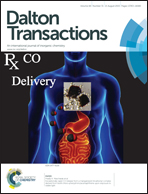Flipping of the coordinated triazine moiety in Cu(i)–L2 and the small electronic factor, κel, for direct outer-sphere cross reactions: syntheses, crystal structures and redox behaviour of copper(ii)/(i)–L2 complexes (L = 3-(2-pyridyl)-5,6-diphenyl-1,2,4-triazine)†
Abstract
Six-coordinate [Cu(pdt)2(H2O)2]2+ and four-coordinate [Cu(pdt)2]+ complexes were synthesized and the cross redox reactions were studied in acetonitrile (pdt = 3-(2-pyridyl)-5,6-diphenyl-1,2,4-triazine). Single crystal analyses revealed that [Cu(pdt)2(H2O)2](BF4)2 was of pseudo-D2h symmetry with two axial water molecules and two symmetrically coordinated equatorial pdt ligands, while the coordination structure of [Cu(pdt)2]BF4 was a squashed tetrahedron (dihedral angle = 54.87°) with an asymmetric coordination by two pdt ligands: one pdt ligand was coordinated to Cu(I) through pyridine-N and triazine-N2 while another pdt ligand was coordinated through pyridine-N and triazine-N4, and a stacking interaction between the phenyl ring on one pdt ligand and the triazine ring on another pdt ligand caused the squashed structure and non-equivalent Cu–N bond lengths. The cyclic voltammograms for [Cu(pdt)2(H2O)2]2+ and [Cu(pdt)2]+ in acetonitrile were identical to each other and quasi-reversible. The reduction of [Cu(pdt)2(H2O)2]2+ by decamethylferrocene and the oxidation of [Cu(pdt)2]+ by [Co(2,2′-bipyridine)3]3+ in acetonitrile revealed that both cross reactions were sluggish through a gated process (the structural change took place prior to the electron transfer) accompanied by slow direct electron transfer processes. It was found that the triazine ring of the coordinated pdt ligand rotates around the C–C bond between the triazine and pyridine rings with the kinetic parameters k = 51 ± 5 s−1 (297.8 K), ΔH‡ = 6.2 ± 1.1 kJ mol−1 and ΔS‡ = −192 ± 4 J mol−1 K−1. The electron self-exchange process was directly measured using the line-broadening method: kex = (9.9 ± 0.5) × 104 kg mol−1 s−1 (297.8 K) with ΔH‡ = 44 ± 7 kJ mol−1 and ΔS‡ = 0.2 ± 2.6 J mol−1 K−1. By comparing this rate constant with the self-exchange rate constants estimated from the cross reactions using the Marcus cross relation, the non-adiabaticity (electronic) factors, κel, for the direct electron transfer processes between [Cu(pdt)2]+/2+ and non-copper metal (Fe2+ and Co3+) complexes were estimated as ca. 10−7, indicating that the electronic coupling between the d orbitals of copper and of non-copper metals is very small.


 Please wait while we load your content...
Please wait while we load your content...